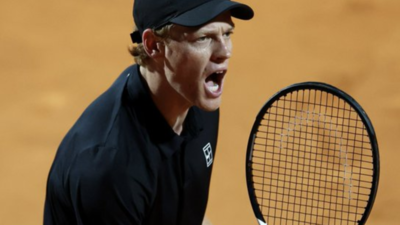ARTICLE AD BOX

Jannik Sinner has just lived out the kind of script Hollywood might reject for being too on the nose: young prodigy, doping cloud, short ban, glorious return, and finally, the crown jewel — a Wimbledon title on the hallowed grass of Centre Court.He didn’t just beat Carlos Alcaraz in the final; he beat Novak Djokovic in the semis — the man who’s made a second career out of destroying generational dreams. And yet, for many watching, the taste is bittersweet. Because running parallel to the fairytale is the quiet but persistent question: what about the drugs?No, not syringes-in-the-locker-room kind of drugs. Just a whisper of Clostebol — a name that sounds more like a cough syrup than a career-altering compound.
But in sport, as in politics, it's not the crime; it’s the chemical.
So, what on earth is Clostebol?
Clostebol is a synthetic anabolic steroid, essentially a Frankenstein cousin of testosterone with just enough bite to help muscle recovery, but not enough to turn you into Ivan Drago. Think of it as the steroid equivalent of a smart casual dress code: won’t win you a bodybuilding contest, but may give you an edge in a five-set war of attrition.It’s often used in topical creams in parts of Europe to treat wounds, ulcers, and skin abrasions.
In Italy, Trofodermin — a clostebol-based ointment — is as common as Volini is in Indian households. So yes, it’s medically legitimate. But in sports? Completely banned. No exceptions. Not even for a scraped shin or your physio’s poor hygiene.The Sinner saga: Contamination, conviction, and comebackSinner tested positive for Clostebol in March 2024 — twice, in fact. But not in your usual doping scandal fashion. According to his team, the steroid didn’t come from pills or injections, but from his physiotherapist’s cut finger.
Yes, really.Apparently, the physio had been using a clostebol-laced cream on himself and then massaged Sinner’s legs without gloves. Nine days of leg massages later, the world's top-ranked player had enough trace amounts in his system to show up on a drug test. Microscopic levels — picograms. A trillionth of a gram. You’d find more chemical residue in a municipal swimming pool.Anti-doping authorities believed the explanation.
Sort of. They ruled he bore no significant fault, stripped him of his Indian Wells prize money, and then quietly negotiated a three-month suspension — a sort of sporting house arrest. Sinner took the ban, did the time, and returned just in time to storm through the clay and grass seasons. Now he’s Wimbledon champion.
The ghosts of tennis past: Enter Agassi, with meth
If all this sounds surreal, remember: tennis has been here before.In the late 1990s, Andre Agassi tested positive for methamphetamine — yes, the same stuff that fuels Breaking Bad plotlines.
He blamed it on a spiked soda from his assistant “Slim” (yes, really), and the ATP, in a fit of convenient bureaucracy, accepted the excuse and buried the result. It didn’t come out until Agassi admitted it in his 2009 memoir, Open, turning a potentially career-ending scandal into a literary redemption arc.Sinner’s case isn’t nearly as dramatic — no crystal meth, no faux-cocaine denial — but the echoes are unmistakable.
Tennis has always had a peculiar relationship with drug use. It forgives quietly, forgets efficiently, and moves on gracefully — preferably in white.
Why fans are divided
To Sinner’s supporters, this is a non-story. A nothingburger served cold. He didn’t cheat, didn’t inject, didn’t knowingly dope. He explained, he cooperated, he accepted a suspension. Move on.But to critics, the issue isn’t what Sinner did — it’s what the system allows. A three-month slap on the wrist for a banned substance, a return timed perfectly for the Grand Slams, and now a standing ovation at Wimbledon. If the same had happened to a lower-ranked player, would the outcome have been so lenient? If the banned substance had been found in, say, an Eastern European wild card, would the public discourse be so forgiving?And most damning of all: if Novak Djokovic had tested positive for clostebol, would anyone believe the “accidental cream contamination” narrative?
The larger dilemma: Intent vs presence
Anti-doping rules are built on strict liability — you’re responsible for what’s in your body, regardless of intent.
But elite sport often muddies the water. Intent becomes a legal grey zone, contamination becomes plausible deniability, and reputation often sways judgment more than science.Clostebol, by itself, won’t make you a Grand Slam champion. But it might help you recover a little faster, push a little harder, get through that fifth set with a bit more gas in the tank. And in a sport where margins are everything — a foot fault here, a net cord there — that matters.
So, is Sinner’s Wimbledon win tainted?
Officially? No. He served his time. He’s clean. He’s earned it.Culturally? That’s trickier.This is tennis, after all — a sport that prizes elegance, tradition, and the illusion of perfection. A grass court is sacred. A champion is supposed to be not just victorious, but virtuous. Sinner’s win may be legitimate, but for some fans, it’s no longer immaculate.And in the end, perhaps that’s the true cost of Clostebol — not the suspension, not the missed points, but the asterisk some will always see, even if it's written in invisible ink.Wimbledon 2025 may have a new king. But the crown, as always, weighs heavy — especially when there’s steroid cream on the throne.



.png)
.png)
.png)
















 5 hours ago
7
5 hours ago
7









 English (US) ·
English (US) ·